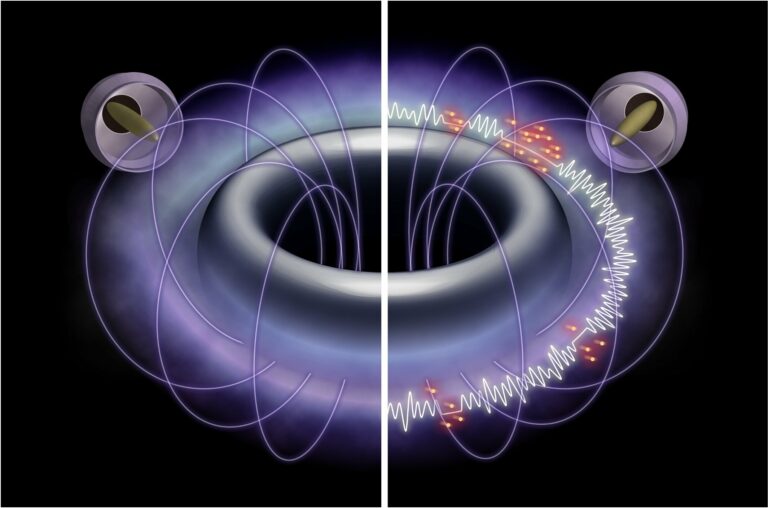Laboratory research generates synthetic magnetosphere to investigate spontaneous excitation of chorus emissions
The RT-1 project seeks to gain insights from nature and develop a high-performance plasma with magnetosphere-like properties to achieve advanced fusion energy. Additionally, the artificial magnetosphere provides a controlled environment to study natural phenomena and understand their mechanisms.
Located at the University of Tokyo, the Ring Trap-1 (RT-1) is an experimental setup that utilizes high-temperature superconducting technology. By magnetically levitating a dipole field coil, it enables plasma experiments to be conducted in an environment similar to that of planetary magnetospheres.
The whistler mode chorus emission, which is observed in the space surrounding Earth known as “Geospace,” is a significant phenomenon associated with aurorae and space weather. Extensive research on chorus emission has been conducted through spacecraft observations, theoretical studies, and numerical simulations.
While spacecraft serve as valuable tools for studying the actual space environment, comprehending the vast and intricate system of the planetary magnetosphere in its entirety remains a challenging task. Additionally, manipulating the space environment is no easy feat for human beings.
On the other hand, laboratory settings provide us with the opportunity to create a simplified research subject that is extracted from the complex properties of nature within a controlled environment. Consequently, experimental studies are expected to complement the observation and theory of understanding chorus emissions. However, replicating a magnetospheric environment in the laboratory is not a straightforward endeavor. To date, no laboratory experiments on chorus emissions in a magnetospheric dipole magnetic field have been conducted.

A team of researchers from the National Institute for Fusion Science in Toki, Japan, and the Graduate School of Frontier Sciences at the University of Tokyo in Kashiwa, Japan, has achieved successful laboratory studies on whistler mode chorus emission using the RT-1 device. This device creates an “artificial magnetosphere” by employing a magnetically levitated superconducting coil to generate a dipole magnetic field similar to that of a planetary magnetosphere within the laboratory.
Utilizing high-temperature superconducting technology, a 110 kg coil is magnetically levitated within a vacuum vessel, and the resulting magnetic field confines the plasma. This unique setup allows for operation without the need for any mechanical support structures for the coil, enabling the generation of plasma in an environment resembling that of a planetary magnetosphere, even within a ground-based facility.
The research team conducted a study where they filled the RT-1 vacuum vessel with hydrogen gas and utilized microwaves to generate high-performance hydrogen plasma. The focus was primarily on heating electrons to achieve this.
During the experiments, plasmas were generated in different states and investigations were carried out to understand the generation of waves. It was observed that the spontaneous production of the whistler wave chorus emission occurred when the plasma contained a significant ratio of high-temperature electrons.
Measurements were taken to analyze the strength and frequency of the chorus emission from the plasma, with a specific emphasis on its density and the state of the high-temperature electrons.
The findings, which have been published in Nature Communications, revealed that the generation of the chorus emission is driven by an increase in high-temperature electrons, which are responsible for plasma pressure. Furthermore, increasing the overall plasma density was found to suppress the generation of the chorus emission.
This study has provided clarity on the fact that the chorus emission is a universal phenomenon that occurs in plasma with high-temperature electrons in a simple dipole magnetic field. The properties discovered during the experiment, such as appearance conditions and wave propagation, can contribute to a better understanding of the chorus emission and related phenomena observed in geospace.
Chorus emissions, which are electromagnetic waves, have the potential to accelerate hot electrons to higher energy states, leading to the formation of aurorae and satellite failures. These electromagnetic waves, along with energetic particles, play a crucial role in space weather phenomena.
In geospace, when explosive events like flares occur on the solar surface, they give rise to magnetic storms that cause significant fluctuations in the electromagnetic field and generate a large number of energetic particles. This not only results in satellite failures and impacts the ozone layer but also disrupts power and communication networks on the ground.
The study of space weather phenomena has become increasingly important due to the expansion of human activity. However, there are still many unresolved mechanisms and phenomena in this field. This research aims to contribute to a better understanding of the diverse space weather phenomena by investigating the underlying mechanisms.
In the field of fusion plasma, which seeks to solve energy problems, the interaction between particles and waves leading to the loss of particles and structure formation is a major research focus. To achieve fusion, it is crucial to have a precise understanding of the complex interactions between spontaneously excited waves and plasma.
High-temperature plasmas for fusion have shown wave phenomena with frequency variations, similar to the chorus emission. This suggests the existence of a shared physical mechanism between fusion and space plasmas.
The findings of this study represent a significant step towards comprehending the common physical phenomena observed in both fusion and space plasmas. It is expected that future research will further advance through increased collaboration between these two fields.
Whistler waves, which are fundamental waves in plasma, play a crucial role in these phenomena. In the observed chorus emissions around geospace and Jupiter, there are repeated fluctuation events with frequency variations resembling birdsong. These events are believed to be closely connected to aurorae and space weather phenomena, including the generation and transportation of high-energy electrons.
This article is republished from PhysORG under a Creative Commons license. Read the original article.
Do not forget to share your opinion with us to provide you with the best posts !




0 Comments